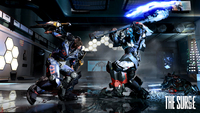|
|

|
PLATFORM
|
PS4
|
BATTLE SYSTEM
|

|
INTERACTION
|

|
ORIGINALITY
|

|
STORY
|

|
MUSIC & SOUND
|

|
VISUALS
|

|
CHALLENGE
|
Very Hard
|
COMPLETION TIME
|
20-40 Hours
|
|
OVERALL

|
+ You'll die. You'll curse. You'll love it.
+ Strategic dismemberment never gets old
- Unclear objectives and very little guidance
- Story is a bit bare-bones
|
Click here for scoring definitions
|
|
|
The Surge is Demon's Souls set in a dystopian future, with lots of dismemberment. That's all the review some people will probably need. Feel free to stop reading now and buy it for yourself. For those that prefer a little more meat to their reviews, read on to see how developer Deck13's sophomore effort into the hardcore Souls-style gameplay both builds on what came before and carves out a completely unique niche while staying true to the familiar trappings it's based on.
The story in The Surge, which is purposely kept vague at the beginning and reveals itself little by little, revolves around humanity's decline. In this dystopian future vision of Earth, most of the planet's resources have been used up, and its ozone layer is in danger of total collapse. The mega corporation CREO has been taking strides toward renewing the Earth's protective barrier, and seems to be trying to slow down mankind's fast-approaching extinction. Players take on the role of the wheelchair-bound Warren, who has decided to enlist in exchange for being fitted into a fully mechanized Exo Rig, giving him the renewed use of his legs. During a disturbing and difficult-to-watch intro, in which the fully-automated surgical suite forgets to anesthetize Warren prior to the extensive full-body surgery, it becomes clear that something has gone wrong with the machines in the facility. Waking to being unceremoniously dragged to the refuse dump, Warren must defend his life and fix the glitch in the matrix in his effort to escape the facility.
Calling The Surge a Souls clone seems like a fair statement. The bulk of its design has been transferred over wholesale from that same tried and true formula, and most facets of gameplay will be immediately familiar to series veterans. Killing foes, in this case robots and crazed humans encased in sharp-edged metal rigs, nets tech scrap, which can be exchanged in large quantities to level up Warren's Exo Rig. Dying, on the other hand, causes all held tech scrap to drop, giving Warren exactly one chance to reclaim it before it's lost forever. Sprinkled around the industrial complex of the CREO Corporation are ops centers — safe zones — where players can heal, save, and level up, causing slain enemies to respawn.
For every way that The Surge apes FromSoftware's long-running franchise, there are some immediate connections, and improvements, to Deck13's own previous effort, Lords of the Fallen, itself a Souls-like. The game offers players the option to bank tech scrap at save points, even when not enough of it has been earned to gain a full level. The trade-off to this is that the longer players go without visiting a medbay or dying — in other words, the higher risk of losing it all in one ill-fated moment they're willing to take — the greater the tech scrap multiplier becomes. Playing it safe and banking all scrap or healing up at every available medbay means it can't be lost, but the grind to the higher levels becomes that much longer. Gaining back lost tech scrap after dying also comes with a time limit; once the timer hits zero, that tech scrap is gone for good.
 Go ahead. Find my weak spot. I dare you.
Go ahead. Find my weak spot. I dare you.
|
|
One thing that is wholly unique to The Surge is its approach to combat. The game does away with the concept of light and heavy attacks, instead letting the player execute vertical and horizontal attacks. While this sounds like it opens up a lot of tactical freedom, in execution it lacks the precision to go beyond simple button-mashing. Combat is too fast-paced. Reacting to enemies' attack flurries is too chaotic to take the time to ponder from which direction your next hit should come. Stringing together attacks creates combos, which change based on the weapon or input order of attacks. A combo with the Vibro Cutter, for example, may include a leg swipe that knocks most bipedal enemies down, opening them up for even greater damage, while a combo using the Firebug Throttle hand-to-hand melee weapon includes a quick backwards dodge to get Warren out of harm's way. The trick, then, lies in figuring out which weapons and combos work best in specific situations.
Mainly, though, the game's draw is how it handles its weapon and armor acquisition and upgrading. As the game progresses, players constantly encounter new and stronger foes. Early on, there are lots of workers, like Warren, wearing similar low-level Exo Rigs, while later in the game, as areas are cleared and enemies become more aware of Warren's presence, more elite security personnel will patrol the facility's corridors. Different enemy types do not have access to the same armor and weapons, giving Warren a chance to collect armor sets directly worn by enemies. The first time a new head, arm, leg, or body armor piece drops, it's in the form of a schematic, which is automatically uploaded to the Gear Assembly station in the ops center. Each subsequent drop of that same part is turned into resources — alloys, processors, regulators — used in crafting and upgrading. All armor and weapons can also be individually upgraded several times, increasing stats, while wearing a complete matching set offers its own stat boosts.
Enemies get the same benefit from armor that Warren does, meaning that smacking a baddie in his heavily-armored head will not have nearly the same effect as slicing into unprotected flesh. Warren's Exo Rig lets him lock on to specific body parts and tells the player which ones, if any, are unprotected. Here's where the directional strikes once again come into play: swiping from the right while targeting the arm on the opposite side will likely cause the blow to glance off the armored chest or other arm instead. While this is a realistic approach, it comes at the cost of leaving some things up to chance and sacrificing a bit of precision. Dropping enemies by targeting their weak spots may be a quick way to dispatch them, but is also an easy trap to fall into. While materials will occasionally drop from enemies defeated like this, it's their armored parts that players need to collect in order to upgrade their own. This may take longer and have a greater chance of suffering damage, but it nets a much higher drop rate of schematics and materials, as well as some epic slow-motion dismemberment scenes.
 You will fight this — and that's just the first boss battle.
You will fight this — and that's just the first boss battle.
|
|
It should almost go without saying, being a Souls-like, that The Surge has a pretty substantial degree of difficulty. True to form, a single enemy that you're not geared for, or even two lower-level foes, can easily take Warren out. Though pattern recognition does factor in, there are a multitude of different baddies who react differently and even have different fighting styles to better complement their weapons. Staff-wielding security forces jump and flip and make good use of their weapon's extended range, while the slower flamethrowers shamble along, content to cause continual damage via immolation. At least the human enemies have the weakness of being flesh and bone under that metal shell; some of the machines are simpler to run from than fight, unless absolutely necessary. Then there are the handful of bosses, most of which are machines of extremely large proportions with a variety of forms, parts, and attack patterns. It's not uncommon to spend a full play session just working out attack patterns and exploitable weaknesses for a single boss, dying countless times in the process. For some, this will prove too frustrating to deal with. But deaths in The Surge are rarely cheap, and the promise of making it even just a few steps further on each attempt, around the next corner, through the next shortcut is enough of a carrot on a stick to keep frustration at bay for those willing to face a challenge.
In the presentation department, The Surge is no slouch either. Environments, textures, and lighting all look great. What is a joy, however, is the level of detail absolutely crammed into the designs, from Warren's ever-changing, cobbled-together armor loadout to the meticulous attention paid to the towering bosses. Players may suffer more than one death simply because they were too busy gawking at a boss's movement animations and forgot to dodge a fatal blow. Sound design is equally impressive, and plays a large role in making the world come alive. There are great moments when this becomes apparent, like hearing a mysterious rhythmic clanking sound, then turning the corner and seeing that they were caused by a human, obviously driven mad, slamming his metal-armored head against a wall. Not surprisingly, given the setting, friendly humans are few and far between, so dialog is sparse. Music overall takes a back seat other than creating creepy atmosphere, though it's worth mentioning that the lonesome country western song that plays in every single ops center gets redundant very quickly.
Though the combat is engaging enough to keep players coming back for more even in the face of the high level of challenge, there are a few things that can dampen the experience. During the final few areas of the game, the otherwise rock-solid level design becomes a bit cumbersome. Throughout The Surge, areas tend to constantly double back on themselves, opening up pathways and shortcuts to get from the save point to the boss in a relatively short time. This is as it should be, but the final few areas are so convoluted that the lack of a map or other navigation interface is greatly missed. To make matters worse, Warren's current objective is often obfuscated by the threadbare narrative; players must simply rely on moving forward into the only possible direction until they reach the next area. But when the level design branches into a multitude of unexplored corridors, laboratories, and rooms, each stuffed to the brim with powerful enemies, just a little guidance would have gone a long way.
 Up close and personal battles are Warren's bread and butter.
Up close and personal battles are Warren's bread and butter.
|
|
Apart from convoluted level design near the end and the lack of guidance, other issues include things like an ending that's a little disappointing and abrupt. Completing the game does unlock a New Game+ mode, which lets players keep their stats and upgraded gear while playing through the game a second time, mixing stronger enemies in with the weaker ones. The second playthrough puts the first to shame in terms of difficulty; even with end-game gear, the upscaled foes are heavy hitters, encouraging only the most battle-hardened to persevere through it all a second time.
The few issues aside, The Surge is a great addition to the hardcore subgenre. The level design, for the most part, is engaging and doles out a feeling of accomplishment whenever a new shortcut has been unlocked, doing a great job of spurring players on to "just one more try". More than just mere window dressing, the areas Warren treks through on his journey tell a large part of the story, from research labs to greenhouses and, eventually, the office suites and production studios on the executive floors. Delving into unlit maintenance shafts and prowling catwalks suspended above manufacturing floors, always expecting a wailing lunatic to jump out of the shadows, strongly evokes a Dead Space-like horror atmosphere, while leveling up the Exo Rig and obtaining new tech enables players to backtrack and explore in true Metroidvania fashion. While it isn't a revolution on the tried-and-true gameplay formula, it nevertheless takes the genre into a fresh direction, retaining what makes it work for fans while putting some unique touches on the combat system, setting, and overall flavor. It presents a bleak, dystopian future and is wracked with unrelenting difficulty, but if the cost of admission is a few prematurely grey hairs, it's absolutely worth it.
Review Archives
|









